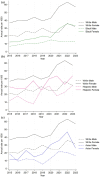Patterns of Antidepressant and Antianxiety Medication Prescriptions in Pediatric Primary Care in the U.S
- PMID: 40525406
- PMCID: PMC12174736
- DOI: 10.1177/21501319251347906
Patterns of Antidepressant and Antianxiety Medication Prescriptions in Pediatric Primary Care in the U.S
Abstract
Background: Shortages of pediatric mental health (MH) specialty providers have left pediatric primary care providers (PPCP) to care for the influx of youth with MH needs. This study examined trends in prescription of antidepressants and antianxiety medication in pediatric primary care clinics from 2015 to 2023.
Methods: Annual rates of prescription of antidepressant and/or antianxiety medication orders were calculated by race/ethnicity, sex, and practice type. Adjusted mean differences (AMD) were calculated and compared for the beginning and end of the study period.
Results: Prescription orders for antianxiety and/or antidepressant medications increased between 2015 and 2023 across all patients but was greatest among Hispanic youth (AMD = 50.9, 95% CI = 15.3-86.4) and among females irrespective of race (AMD = 29.3, 95% CI = 16.8-41.7). Despite these increases, non-Hispanic White youth were more likely to receive prescriptions than Hispanic and non-Hispanic Asian or Black youth across time periods. Family practices (treating adults and children) had the highest rates of prescription across time periods.
Conclusions: While prescription rates for antidepressant and antianxiety medications have increased overall, treatment gaps between White and ethnoracially minoritized pediatric patients have persisted. Differences in prescribing patterns between practice environments suggest PPCPs may be more comfortable prescribing MH medications in family practices relative to pediatric practices.
Keywords: adolescent; anxiety; depression; disparities; medication; pediatrics; primary care; suicide.
Conflict of interest statement
Declaration of Conflicting InterestsThe author(s) declared no potential conflicts of interest with respect to the research, authorship, and/or publication of this article.
Figures




Similar articles
-
Surveillance for Violent Deaths - National Violent Death Reporting System, 50 States, the District of Columbia, and Puerto Rico, 2022.MMWR Surveill Summ. 2025 Jun 12;74(5):1-42. doi: 10.15585/mmwr.ss7405a1. MMWR Surveill Summ. 2025. PMID: 40493548 Free PMC article.
-
Racial and Ethnic Disparities in Prescription of a Novel Agent in Medical Management of Primary Open-Angle Glaucoma.Ophthalmic Epidemiol. 2025 Aug;32(4):374-381. doi: 10.1080/09286586.2024.2401046. Epub 2024 Oct 10. Ophthalmic Epidemiol. 2025. PMID: 39389153
-
Psychiatric comorbidities and prescribing tendencies of sleep medications and related medications in young people with insomnia: a United States commercial claims-based analysis.Sleep. 2024 May 10;47(5):zsae057. doi: 10.1093/sleep/zsae057. Sleep. 2024. PMID: 38430553 Free PMC article.
-
Prevalence and odds of anxiety and depression in cutaneous malignant melanoma: a proportional meta-analysis and regression.Br J Dermatol. 2024 Jun 20;191(1):24-35. doi: 10.1093/bjd/ljae011. Br J Dermatol. 2024. PMID: 38197404
-
Association of social determinants of health with first antiseizure medication prescription for patients with newly diagnosed epilepsy: A systematic review and meta-analysis.Epilepsia. 2025 May;66(5):1560-1572. doi: 10.1111/epi.18277. Epub 2025 Jan 18. Epilepsia. 2025. PMID: 39825782
References
MeSH terms
Substances
LinkOut - more resources
Full Text Sources
Medical

